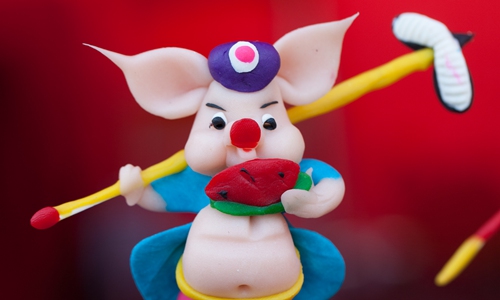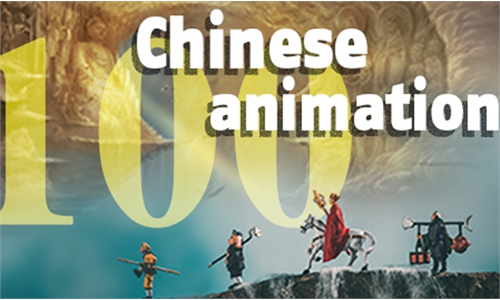
A dough figurine of the Chinese cartoon character Pigsy Photo: VCG
Pigsy Eats Watermelon: early animated film inspired by paper-cut art
Pigsy Eats Watermelon was an animated Chinese film inspired by the country's paper cutting folk tradition.
The animated film debuted in 1958, a time when the Chinese animation industry was just starting to emerge. Though the animated film was only 20 minutes long, its colorful presentation left a deep impression on audiences.
The production marked the first use of cutout animation, a type of stop-motion animation, in Chinese animation history. What set the film apart is that the puppets used for the stop-motion animation used the aesthetics of Chinese paper-cut art.
Pigsy, the main character, and the story of the short film were inspired by the classic novel Journey to the West. The story takes place during the Monk Xuanzang and his apprentices' journey to the western regions. Pigsy, one of the apprentices, eats a whole watermelon that he was supposed to share with the whole crew. To punish him for his greed, the Monkey King, Sun Wukong, turns into a slippery watermelon rind and trips Pigsy.
Similar to China's first full-length animation film Princess Iron Fan, the 1958 production was created by the Fathers of Chinese animation, the Wan Brothers, with Wan Guzhan as director.
Following Wan's return from Hong Kong to work at the cradle of Chinese mainland animation, the Shanghai Animation Film Studio, he dedicated himself to making a film that could embody the country's traditional folk arts.
Besides the director, animation filmmakers such as screenwriter Bao Lei, vice director Chen Zhenghong and art and motion designers Zhan Tongxuan, Xie Yougen and Hu Jingqing formed the crew for the experimental production.
In early 1957, they attempted their first shoot. During this, the animators had to climb on and off a wood stool for every frame, but the end product was a failure since the final product was too shaky and incoherent.
After several similar experiments and failures, the crew finally achieved success with the 1958 production.
Chinese paper-cut animation was inspired by another unique folk tradition called shadow puppetry, especially when it came to movement techniques. Both art forms involve manipulating the assemble joints of the puppets to make them move.

